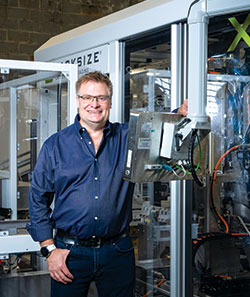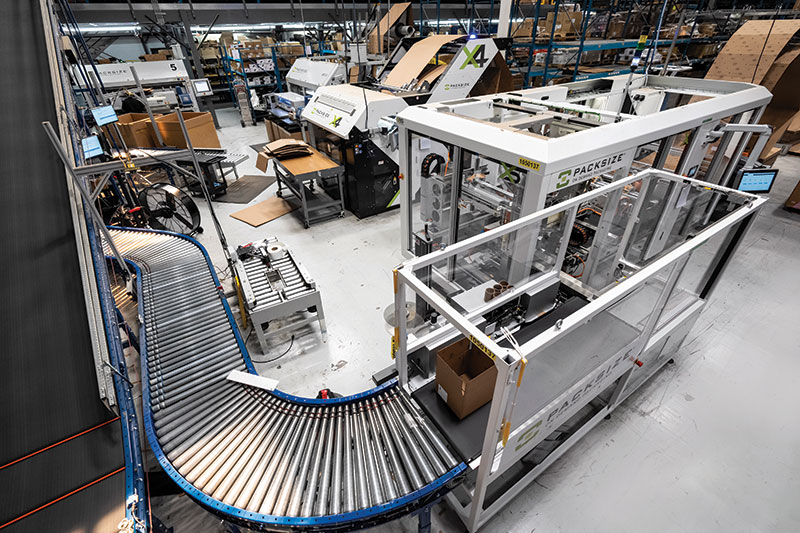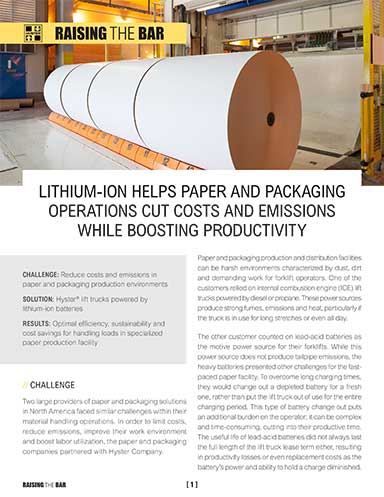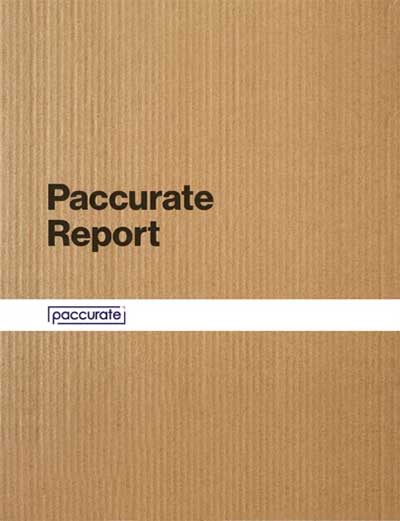Automated packaging makes noise at Crutchfield Company
A leader in the home audio distribution space, Crutchfield is using on-demand packaging to get packages out the door and to save on labor and packaging costs.
Unless you keep up with ever-changing technology, buying audio and video equipment for your home, car or boat can be a confusing and expensive experience, especially if you happen to make a mistake. Technical expertise and customer service are critical to doing it right.

Enter Crutchfield, a nearly 50-year-old company founded on the concept of helping customers navigate the home electronics maze. The company website is chock-full of testimonials like: “You call Crutchfield as a new customer and hang up as a new friend.”
That level of customer service is not just the result of highly trained customer service reps; it’s also the result of order fulfillment processes designed to deliver on the company’s service promises for fast and damage-free deliveries.
An on-demand, right-sized packaging system (Packsize) is at the heart of the fulfillment process in Crutchfield’s 150,000-square-foot e-fulfillment facility in Charlottesville, Va., as well as providing overpack protection for bigger, heavier and bulkier items like furniture, home theater systems and large floor speakers handled at a secondary 150,000-square-foot facility nearby. While the items from the primary facility ship UPS, items from the second facility are likely to be shipped as freight because of their weight and size.
Crutchfield is using several different iterations of the on-demand machines, including the newest X5 system, which creates more than 450 shipping containers per hour with capacity to create 600 boxes per hour to accommodate growth. Associates pick orders directly to the boxes, which are then automatically void filled, taped, weighed, dimensioned, labeled and rate shopped before being sorted to a shipping lane.
“Before the on-demand system, we had five to eight packers handling between 2,500 to 3,000 orders per day at manual pack stations. I needed an athletic 20-year-old who could stand at a station and pack all day. Between the challenge of finding those kinds of packers and the space that we needed for order carts, I realized manual packing wasn’t sustainable.” - Chris Groseclose, Crutchfield’s chief fulfillment officer.
Today, that labor has been reallocated throughout the facility; meanwhile the facility is filling about 22,000 orders per week, reaching as many as 7,000 orders during some very busy days. What’s more, the on-demand system has freed up the need to purchase and store boxes in bulk.
The personal becomes professional
Crutchfield was founded in Bill Crutchfield’s garage in Charlottesville in 1974; nearly 50 years later, he’s still the company’s CEO.
Back then, Crutchfield was restoring an old Porsche and couldn’t find information locally or through mail order houses on which aftermarket car stereo would work in his car. After an exhaustive search, he came to two conclusions: He probably wasn’t the only person out there in similar circumstances, and that “expert information, shared by people who really cared about problem-solving, was the answer.”
According to the company history, “when he couldn’t find help from a local or mail-order resource, he started his own business to help car owners upgrade their own sound systems.” The Porsche, by the way, is on display at the corporate headquarters.
Customer service defined the company mission. “Back in 1974, Mr. Crutchfield had some card tables in his garage to process mail orders,” Groseclose notes. “His goal was to get the order packed and down to the post office that same day. That level of customer service is interwoven with our existence.” So was product selection, which has always been extensive.
In 1981, Crutchfield expanded his catalog to include home audio and video, and in the early 1990s he created a vehicle research team to start providing vehicle-specific installation instructions for the DIY customer. That was followed by even more services to enhance the customer experience. Today, Groseclose says, the company is expanding into the consumer medical device market.
Since its early days, Crutchfield has grown to 750 employees (“that’s 750 families that rely on us to make good decisions,” Groseclose says) and the two 150,000-square-foot distribution facilities in Charlottesville.
The primary facility is dedicated to filling orders that involve products that are no larger than 24 x 24 x 14 inches high with a package weight under 35 pounds. “If your order weighs 60 pounds, you’re going to get two boxes,” Groseclose says.
The facility carries between 9,000 and 10,000 SKUs at any given time. As a rule, 60% to 75% of the orders are filled from the primary facility. About 90% of orders ship UPS, with a guaranteed two-day delivery coast to coast. The secondary facility manages returns and also fills orders for non-conveyables. The processes in that facility are manual.
While many distributors try to keep inventory levels low, Crutchfield invests in inventory to augment the customer experience. “We run heavier on stock than our competitors so that we can minimize back orders and offer same-day shipping,” Groseclose says.
He adds that Crutchfield has largely avoided the warehouse labor crunch. “Locally, we’re considered one of the primary employers, and as we’ve grown, Mr. Crutchfield has invested money back into salaries as well as growing our starting salary,” Groseclose says. “That has helped.”
Bringing in automation
Crutchfield has been modernizing its distribution capabilities for the past nine years, a process that is both ongoing—more updates are planned for the future —and that led to the implementation of on-demand packaging. That process is also ongoing.
In 2014, Crutchfield installed a new conveyor system and the first five on-demand packaging machines in the primary facility. At the time, Groseclose says, his team was looking for ways to improve operations. They had investigated adding a Kiva robotics system, but at the end of the day, backed off that investment.
“We had some homegrown cubing software that was effective about half the time,” he says. “We had installed our conveyor, but we wanted a way to get the shipping box delivered to order selectors up front.”
One of his team members searched Google for right-sized packing and up popped Packsize. “Initially, they told us no when we asked for a demo because they thought the cost of corrugated would be more than we were already paying. That conversation went on for about a month before we all agreed to move forward.”
Prior to going live, Packsize sent a team of engineers and trainers, including a software engineer, to work onsite with the local staff that would use the equipment. While this was a new piece of machinery, the integration with the existing software systems was seamless.
Crutchfield associates were also able to train on an existing machine in the secondary building. “The machine in our other building was used for overpack, which was a limited use, but we trusted it,” Groseclose recalls. “We were taking a leap of faith in the primary building because we were now essentially turning over a major portion of our business to a third party, but from day one, the machines worked like a champ.” The change management was also seamless.
About four years later, Crutchfield spent a year beta testing one of the next generation machines. “The next generation machine cut down on labor and made life easier for our operators,” Groseclose recalls. “When the beta period was over, we kept two of our original machines and added some of the new machines.”
Then in June 2022, Crutchfield brought in the latest iteration of Packsize’s equipment. The new system is far more automated. “It makes the box, glues the seam and the bottom and applies the shipping label before the box is inducted onto the conveyor,” Groseclose says. “Other solutions we looked at are doing 30% of the volume that we’re now able to produce. I don’t know of another machine that can do what our new machines do.” He adds that Crutchfield is in the process of replacing two to three of the older machines.
On-demand packaging is now at the front-end of the order fulfillment process. When an order drops, the warehouse management system (WMS) sends dimensional information to the Packsize machines. The machines make and label the boxes, which are then scanned onto the conveyor line. That in turn determines where the boxes are delivered to start the picking process. Once all of the items have been loaded, the box goes to one of two packing lines where dunnage is added if required and then the box is taped, sealed and labeled for shipping.
A big change with the new machines, which are larger and more complex than the original equipment, is that a Packsize technician works onsite to keep the equipment running. “We have a team of three people who have some experience working with complex machines and can do some maintenance, but having an onsite tech is worth the money we are spending,” says Groseclose. The tech also takes care of the other, older machines.
Groseclose estimates the system is generating between $3 million and $4 million in annual savings through a combination of materials and freight savings. “My void fill consumption went down by about 57%; our boxes are mostly right sized, and it’s saved us a boatload in freight costs,” he says.
In addition to the savings in labor and ability to grow the business, Crutchfield has also freed up space and capital that was once allocated to buying packaging materials in bulk. “I used to purchase about 20 different box sizes, from something as small as a shoebox to something that was 30 x 30 x 20 inches, and I’d buy three to four months of inventory at a time to get a bulk discount,” Groseclose recalls. “We’ve eliminated that expense and the space required to store the materials.”
The customer also wins because they’re not getting over-sized boxes. After almost a decade of working with on-demand packaging, including a year with the new machines, Groseclose notes that “we have never had a day that we didn’t get all of the shipments out. The machines have literally never let us down.”
Crutchfield is not done automating. While his current operations are filling the bill, Groseclose is looking at the next 10 years to keep up with customer expectations and the labor market. To that end, he’s investigating automated storage and retrieval systems (AS/RS) and robotics solutions.
“We’re a niche player in the consumer market and our customer service is what keeps us relevant,” he says. “I believe that if you’re not looking at automation and robotics, you’re going to be left behind from a labor cost perspective.”
Automating packaging
On-demand packaging is saving big at Crutchfield
Crutchfield,
Charlottesville, Va.
Size: 150,000 square feet for conveyables; 150,000 square feet for non-conveyables ITEMS: Consumer electronics, especially audio
SKUs: 14,000
Throuput: 22,000 orders per week
Shifts: 3 shifts per day. Sunday through Thursday, Friday, 7 a.m. until midnight
Crutchfield, a leading distributor of audio equipment for the home, car and boat, is relying on on-demand packaging to reduce its carbon footprint and reallocate labor.
Receiving: Newly arrived trucks are unloaded at the dock and inspected to confirm that there is no visible damage to the retail package integrity and verify the count and color of the product. If the shipping pallet is oversized, the product is re-palletized onto a standard pallet. Once it passes inspection, it is scanned into the system and the inventory is now available for sale.
Put away: Crutchfield does not have directed put away. Instead, the facility’s most experienced operators scan pallets into a location in the bulk storage area based on their knowledge of the product.
Replenishment: As a rule, the system keeps about two weeks of demand in a pick face. However, pick locations are replenished on a rolling 28-day algorithm that monitors the velocity of a SKU. If the velocity changes, a particular SKU can be reslotted to a faster or slower pick location from where it is currently stored.
Picking: Picking takes place across 12 pick zones, including floor level and mezzanine level pick locations. When the warehouse management system (WMS) drops an order to the floor, it first goes to the on-demand packaging system, which creates the right size shipping box for the items in that order.
A license plate bar code is applied that includes dimensional information, the customer’s name and address and the items ordered. The bar code is automatically scanned as the box is inducted onto the conveyor system. Following the scan, the box is diverted to one of the pick zones.
Once it reaches a pick zone, an associate scans the label and is directed to the pick locations in that zone. If items from other zones are required, the box is conveyed to the next location. If a box misses a zone, it will recirculate and go back until all of the items for that order have been picked.
Pack and ship: Once picking is complete, the box is conveyed to a weigh and tape station to initiate packing and shipping. Void fill is added before the box goes to the case sealer.
From there, it rolls over a scale to capture the box size and weight. With that information, the system automatically rate-shops the package. If the weight is correct, the box travels to the print-and-apply station to receive the shipping label. From there, the shipping sorter directs it to the right lane.
System suppliers
- On-Demand Packaing: Packsize
- Fixed Scanning: Cognex
- WMS: Crutchfield
- Powered Conveyor: TGW and MHS (FORTNA) 24-volt motor-driven roller conveyor
- WCS, Conveyor System: Peak Logic
- Shipping Conveyor & Sorter: TGW
- WCS for Shipping Conveyor & Sorter: Numina Group
- Case Sealers: Pearson
- Print & Apply: Panther
- Rate Shopping: Octane (Indicia), Logistyx Technologies (e2Open) and ConnectShip (UPS).
- Lift Trucks: Crown, Yale, Toyota & Raymond




















